A transistor goes into saturation when both the base-emitter and base-collector junctions are forward biased, basically. So if the collector voltage drops below the base voltage, and the emitter voltage is below the base voltage, then the transistor is in saturation.
Consider this Common Emitter Amplifier circuit. If the collector current is high enough, then the voltage drop across the resistor will be big enough to lower the collector voltage below the base voltage. But note that the collector voltage can't go too low, because the base-collector junction will then be like a forward-biased diode! So, you will have a voltage drop across the base-collector junction but it will not be the usual 0.7V, it will be more like 0.4V.

How do you bring it out of saturation? You could reduce the amount of base drive to the transistor (either reduce the voltage \$V_{be}\$ or reduce the current \$I_b\$), which will then reduce the collector current, which means the voltage drop across the collector resistor will be decreased also. This should increase the voltage at the collector and act to bring the transistor out of saturation. In the "extreme" case, this is what is done when you switch off the transistor. The base drive is removed completely. \$V_{be}\$ is zero and so is \$I_b\$. Therefore, \$I_c\$ is zero too, and the collector resistor is like a pull-up, bringing the collector voltage up to \$V_{CC}\$.
A follow-up comment on your statement
Does a BJT become saturated by
raising Vbe above a certain threshold?
I doubt this, because BJTs, as I
understand them, are
current-controlled, not
voltage-controlled.
There are a number of different ways to describe transistor operation. One is to describe the relationship between currents in the different terminals:
$$I_c = \beta I_b$$
$$I_c = \alpha I_e$$
$$I_e = I_b + I_c$$
etc. Looking at it this way, you could say that the collector current is controlled by the base current.
Another way of looking at it would be to describe the relationship between base-emitter voltage and collector current, which is
$$I_c = I_s e^{\frac{V_{be}} {V_T}}$$
Looking at it this way, the collector current is controlled by the base voltage.
This is definitely confusing. It confused me for a long time. The truth is that you cannot really separate the base-emitter voltage from the base current, because they are interrelated. So both views are correct. When trying to understand a particular circuit or transistor configuration, I find it is usually best just to pick whichever model makes it easiest to analyze.
Edit:
Does a BJT become saturated by
allowing Ib to go over a certain
threshold? If so, does this threshold
depend on the "load" that is connected
to the collector? Is a transistor
saturated simply because Ib is high
enough that the beta of the transistor
is no longer the limiting factor in
Ic?
The bold part is basically exactly right. But the \$I_b\$ threshold is not intrinsic to a particular transistor. It will depend not only on the transistor itself but on the configuration: \$V_{CC}\$, \$R_C\$, \$R_E\$, etc.
